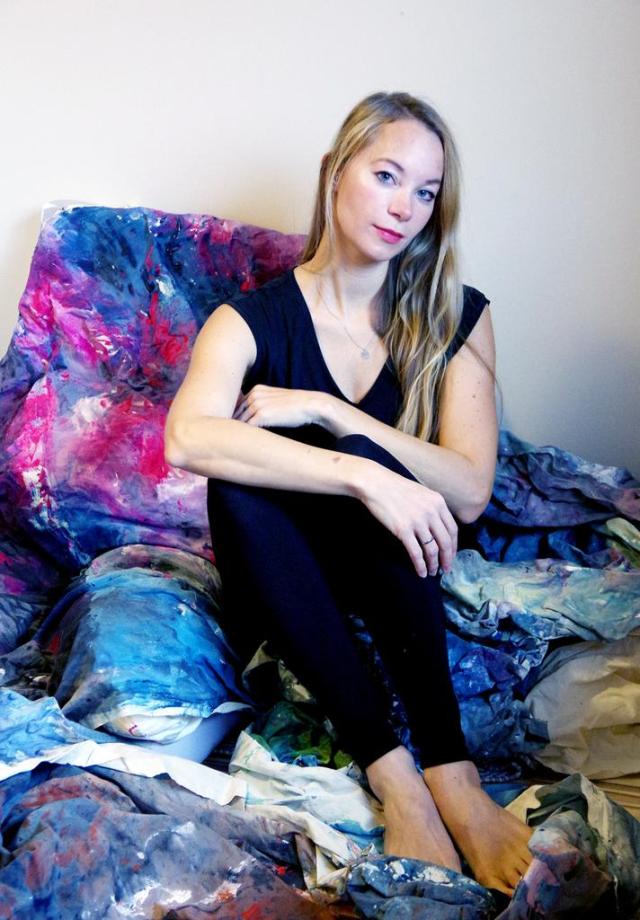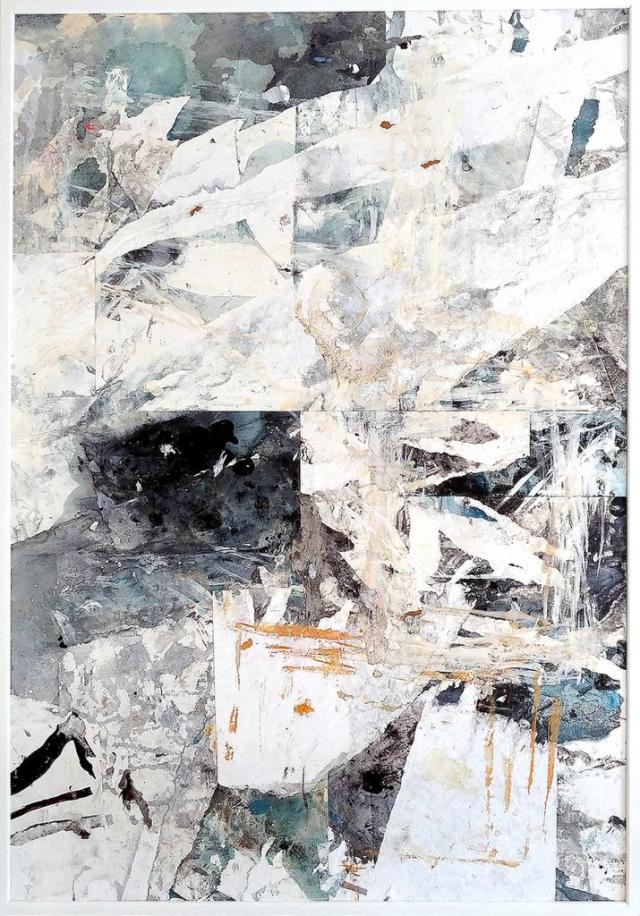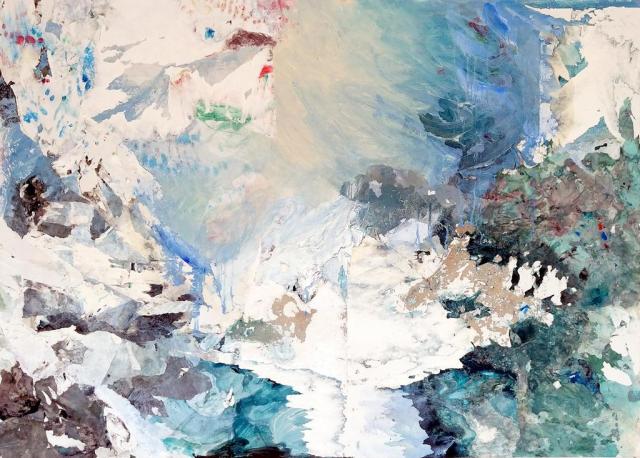 CH.89: If you were to categorize or describe the style of your artwork, what would it be and why?
CH.89: If you were to categorize or describe the style of your artwork, what would it be and why?
DP: It is rough and elegant at the same time – with a touch of playfulness. And I like to equip a work with something that makes it special and unique. I appreciate old frames and like to add a special touch to each piece of art. Some people say they see Japanese influences in my art. It’s not intentional, but it’s something I’ve started to think about. I realized that Eastern aesthetic models and philosophy interest and influence me a lot. I like the restraint and the hidden beauty, the rhythm and the unique dynamics.
CH.89: Where do you draw your inspiration from?
DP: I am very much inspired by nature and its beauty in all its manifestations. From the everyday, inconspicuous or incidental things we pass by every day, Far Eastern aesthetic principles that focus on those aspects that recognize the essence of imperfection and rawness in its most natural form. On moss-covered masonry are beautiful works of art painted by nature; the peeling varnish of the door, painted over hundreds of times over time, revealing its underlying layers; lichen that paints picturesquely over stones, showing formations of time and transience.Seemingly simple and moving states of nature – water in the river, fog, ice and wind find inspiration and expression in my works.It is about preserving and capturing a process in a moment that the artwork reflects.
CH.89: Can you talk a little bit about what your creative thought process is like when starting a new project/ piece of artwork?
DP: I try not to think at all! I always hated the result that came out after I planned and thought too much. It lost all its spontaneity, naturalness and playfulness.I recognize the same thing with my daughter when I watch her play and dance and see how natural and real her movements are. The moment she realizes I’m watching her, she stops doing that – and she does what she thinks I want to see, and it becomes unnatural. Over the last few years, I’ve developed a few technical processes to trick my mind and make my work as natural as possible. When I first started doing this a few years ago, I was like a kid or a teenager and just painted wildly, without boundaries and without thinking, with a lot of water – because I was so annoyed with my own mind! In the meantime, I find myself on a meta-level. I think a lot about what I’m doing, and I know exactly what I’m doing. I look at my paintings for hours. And I work on them for hours, even if it just looks like a few strokes. Only the way it turns out is still the same. I try to trick my mind into creating new structures and shapes. Then I work with them. I sort them, carefully select sections, rework and reinforce structures that have been created, layer them, decollage them by tearing parts away again and reworking them.
CH.89: Is there anything in particular that you would want people to take from your artwork?
DP: I want people to see my artwork as a symbol of the beauty of the hidden and everyday things in life. The beauty of nature in its formations and dynamics – water when it flows, ice, wind, mist. The wind that makes us feel the air around us and gives it presence. Stones that give an image of time in their structures.
 CH.89: Can you talk a little bit about your lifestyle as an artist and what that is like?
CH.89: Can you talk a little bit about your lifestyle as an artist and what that is like?
DP: In a way as an artist you are self-employed and that means you work for yourself and are responsible for everything – all the time. The last three years have been a bit adventurous. Because of my husband’s work, my daughter and I have traveled back and forth between Austria and Bulgaria a lot and we have had the opportunity to find out what it is like to live in another country that is not so well known or prejudiced in Austria. It was a joy to find out what it is really like to live there, it nourished my work so much. I was allowed to get to know and appreciate the beauty of the everyday and imperfect and the wonderful nature. I am very grateful that I had the chance to have these experiences.
CH.89: When starting out an artistic task, do you think it is better to have a particular direction/set plan guiding your way? Or, is it better to act on impulse and go from there?
DP: For me it is better to act on impulse, because my mind tends to just hinder me in the immediate and real expression I want to achieve. But I’m a bit of both – an extreme head person who needs to plan everything through and one who likes to surrender to impulse. I think you can see that in my art.
CH.89: What is one major lesson you’ve learned as an artist thus far?
DP: I’m constantly learning. And that’s the goal of it all. To evolve and embrace the journey. But just as I’ve studied at universities for half my life so far, I’m always evolving my art. I don’t know where it’s going. Moving on is probably the easiest and best lesson you can learn.
CH.89: Do you regard personal style & taste to be of highest importance?
DP: Yes, if it’s real and honest. It means that you think about the things you surround yourself with. That you stand behind the things you like and have around you. Not to buy a great bag or piece of art just because it has a great name. But because you find the content great, with which an artist deals, or simply find a color composition or the rhythm beautiful and it fills you with joy when you look at it. Or because you find the materials of something beautiful and it is handmade.
DP: I think style is important. But for me, style is more about thinking about the things around you. What do I surround myself with and why? Great shoes with a great name mean nothing to me. As a kid, I was almost never allowed to wear beautiful dresses because they could get dirty. When I started working in a department store at 16, alongside school, and earning my own money, I suddenly exploded and bought like crazy all the things I was never allowed to wear.
DP: Today, I try to be more conscious about what I buy. For Christmas, I asked for a bag from a lady in Plovdiv who makes everything by hand. This attitude can still be improved – I am far from where I would like to be! It’s the same with art – I’d rather have an expensive painting that I really love than 10 decorative prints filling my wall. You surround yourself with these things every day, art reflects your personality, can show what you stand for, what you’re passionate about and what you find beautiful and interesting. It’s important to think about that when you buy art.
CH.89: What do you consider to be the hardest thing about being an artist?
 DP: Being an artist is a big challenge on its own. But something about it fascinates me, otherwise I wouldn’t have been doing it for so long. That’s the hardest part. You have to take care of everything yourself as an artist, and existing in the artist world is the hardest part.
DP: Being an artist is a big challenge on its own. But something about it fascinates me, otherwise I wouldn’t have been doing it for so long. That’s the hardest part. You have to take care of everything yourself as an artist, and existing in the artist world is the hardest part.
CH.89: What is one thing you love about being an artist?
DP: I love this question! This is interesting! I think because you can BE. You are allowed to go your own way, you are allowed to dare, make mistakes, fail, get back up and keep going. To try yourself out. That is what I miss in our society. There is no time to try things out. Kids do it all the time naturally. And even they’re not allowed to do that anymore. Even in kindergarten, everything is done according to a schedule and predetermined content. It is terrible! No time for mistakes. And weaknesses. Everything is optimized. In art you have the possibilities for that. The goal is not to look for the one solution, for the one result. It is about changing, finding new solutions in expression by chance and thinking, to try yourself out and if you are on the wrong track – that is just a reflection of the human being. An artist doesn’t make art just for himself, but for society. Is never the one a mirror for all? Art for me is a reflection of all that is human.
CH.89: Is there anyone in particular, any artist’s that inspire you in any way?
DP: I really love Helen Frankenthaler. For me she is the icon of free expression.
CH.89: What do you think of technology in terms of being a useful tool for artists today?
DP: I’m happy about platforms like this, because it’s getting easier for artists to be seen with their work these days. I have a kid and can’t show up at every opening anymore. This has put me in a dichotomy. I don’t want to have to choose child or art. My motherhood, on the other hand, also feeds my art. It is human. And isn’t it more natural to create art about subjects you’ve experienced yourself, right? I’m glad that my work is seen and that I have the opportunity to exchange ideas with other artists, cultural workers and people interested in art.
CH.89: Do you think being an artist allows you to view the world differently from those who don’t follow creative paths?
DP: Yes maybe. But not necessarily. Maybe you see things differently that you deal with every day in your work. That’s always the case. I deal with hidden beauties in the daily environment and nature, so I look right there very closely. By the way, my little daughter, who knows my work, has already developed the same look and draws my attention to these things: “Mom, you have to photograph this, look at the wall…”
CH.89: Do you enjoy traveling? If so, do you have a favorite city?
DP: Italy has always been my favorite country. I spent some time at the arts academy in Bologna and I love the language, the people, the culture. I also liked other hip cities like London, Lisbon, Bangkok or Miami. But now I find the hidden and secret cities much more exciting. That’s why I like Eastern Europe so much. Here everything is not yet so optimized. In Bulgaria, for example, friendliness is not yet so commercialized and people let you know when they have a bad day. I like this naturalness of expression. And the rawness. On one side there are run-down houses and next to them a fancy hotel. I find the contrast really exciting. You can see and feel the past, the signs of the times are everywhere. You’re on less level paths, but you can discover hidden beauties.
 CH.89: Do you have a favorite author or book?
CH.89: Do you have a favorite author or book?
DP: I like the book “Wabi-sabi for Artists, Architects and Designers” by Leonard Koren. Here the basics of the Japanese Wabi sabi beauty aesthetic are well explained. And I think “Save the Game!” by Gerald Hüther and Christoph Quarch is also a must-read. It’s about how necessary play is in our society, because it even improves our brain functions when we design our lives playfully.
CH.89: Any future goals or plans for your artwork?
DP: Yes, I would like to complete my painting diploma in June and I am looking forward to many collaborations and all the exhibitions that will come soon!
CH.89: What does being an artist mean to you?
DP: It is a conscious decision and also social responsibility. I want to transport certain values in my work and hope that people can feel that.
CH.89: What’s the last song you listened to?
DP: I don’t know. At the moment I don’t listen to music, although I actually love music. Lately I prefer silence. Especially when I’m working. At the moment I only hear the soft splashing of the dishwasher behind me, I love that soothing sound.
CH.89: Any last words on the aesthetic of your artwork?
DP: I have an open and playful approach and enjoy new formal and aesthetic surprises. I try not to limit myself and to constantly develop my formal language and content. This broadens my horizon and my art and I hope people can feel that.